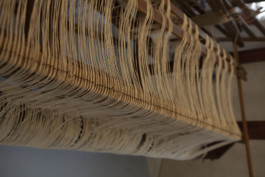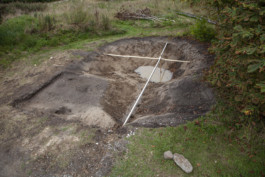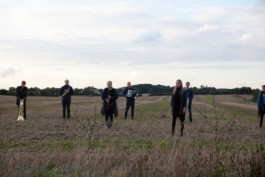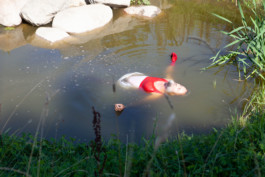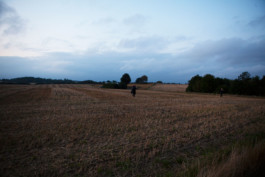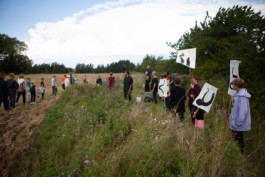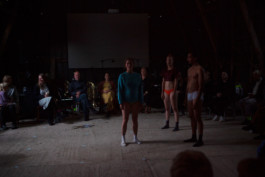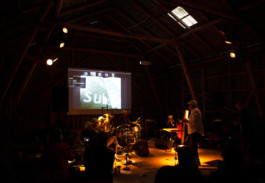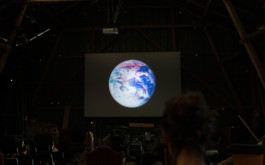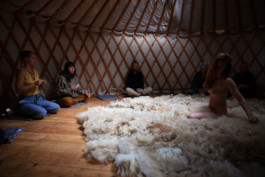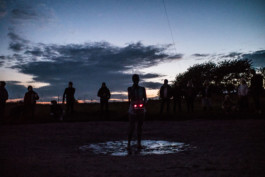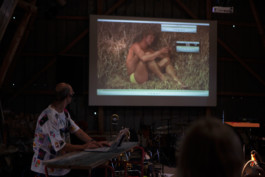INPUT
Ralo Mayer (A) - “Extraterrestrial Ecologies” + Research - The tower the expo the echo the cell (Stoffwechsel)



16.30-17.30 - screening of video “Extraterrestrial Ecologies” + live Q&A from Vienna - Research project “The tower the expo the echo the cell (Stoffwechsel)
In fall 2018, I was in Japan, looking for a Metabolist tower that had inspired an ecological spaceship. I didn’t find the tower, but I found a Space Echo.
Of course, there can’t be an echo in space, because of the vacuum.
The Space Echo RE-201 is a tape delay effects device introduced by electronic music instrument corporation Roland in the early 1970s. Its ingenious mechanism is based on a loop of audio tape constantly re-written and re-read by several magnetic heads. The permutations of the endlessly rearranging tape loop are quite beautiful to watch. The Space Echo also sounds great, and influenced countless musical styles, most prominently Jamaican dub music.
Perhaps, there are echoes in space, nevertheless. Delays in time and reflections across vast distances are quite common, in outer space as on Earth.
Aforementioned ecological spaceship, for instance, is the “Valley Forge” in the 1972 Science Fiction film Silent Running. It houses an ecologically devastated Earth’s last trees, which, in the end, are all watched over by machines of loving grace. Douglas Trumbull, the film’s director, had started out as a special FX expert, working for Kubrick’s 2001, and in 1970, he visited the World Expo in Osaka.
EXPO’70 was perhaps the last expo presenting a vision for the future. It was the future proposed by Metabolism, a Japanese post-war architecture movement. Metabolism linked megastructure ideas with biological concepts of growth and decay as well as traditional Japanese approaches to nature, culture and built environments. A key figure of Metabolism was architect Kiyonori Kikutake, and for EXPO’70, he designed a landmark tower showcasing the movement’s modular megastructure ideas.
It’s safe to say that Trumbull’s spaceship Valley Forge is, well, at least “inspired” by Kikutake’s EXPO tower. Having revisited the plot and ideas of Silent Running many times in my artistic research about the real-life eco-experiment of Biosphere 2, I really wanted to see this inspirational monument in Osaka. But, alas, it had been demolished in the mid 2000s. I visited the area, and could find the site where the tower once stood, a little off from the actual EXPO-park, which today is still a popular recreational park. Over the fence, I could see some dark spot on the ground, and my little drone confirmed these were the outlines of the former tower. Looking at this photo from above, I pondered about the term un-earthing. In its original meaning, used as a transitive verb, it describes the uncovering of an object from the past, most often hidden under layers and sediments. But now, while I’ve been diggin up yet another lost future from the past, I longed for a new interpretation, an intransitive use. What could Un·Earthing mean, as a transformational process of future subjects, as humans leave our home planet?
While I was quite content with both my newly acquired space echo device, and stumbling across a new meaning of Un·Earthing, I kept looking for remains of the metabolist tower.
One night, I found a Japanese website with thousands of photos of the tower. I met the photographer, and he told me he had fallen in love with the futurist tower as a child in the 1970s, and kept picturing it until its demise. Shortly before the tower was dismantled, he was allowed to go up and took photos of its desolated interior. Plants and even little trees had started to grow in the abandoned Metabolist modules. When the tower was torn down, he started to build a small model in his apartment, and after ten years of work, he can now always be with the tower.
When I talked to a curator in Tokyo about my project, he told me a rumor that Kikutake, who died in 2011, had parts of the tower brought to his own home. It wasn’t any house, but the famous Sky House, perhaps the basic unit from which Metabolism had started to form in the 1950s. Located in Tokyo’s Bunkyo ward, Kikutake had built the house with a modular structural concept, and had changed and adapted it several time across the decades.
I visited the Sky House, and as so many surviving Metabolist buildings in Japan, it looked small and inconspicuous within an urban context that had been built later-on. I tried to look into the house’s yard, but there was no sign of any tower parts. I had read that Kikutake’s office was across the street from his home. His name was still on the entrance door. I looked over the fence, and there it was: a little element from the tower. Excited, I took some photos over the fence.
Suddenly, a woman appeared behind me. “What are you doing?”
I told her I’m taking photos of some parts of a tower I had been looking for for months. She unlocked the door, and asked if I would want to take proper photos inside the yard.
It was Kikutake’s wife, who had just arrived home. She apologized many times for putting all the potted plants in front of the tower module part, and I told her about the spaceship full of plants that had been inspired by this tower.
Of course there are echoes in space. And the German word for metabolism is Stoffwechsel, and that term could also be read as metabolism of plots and storytelling.



